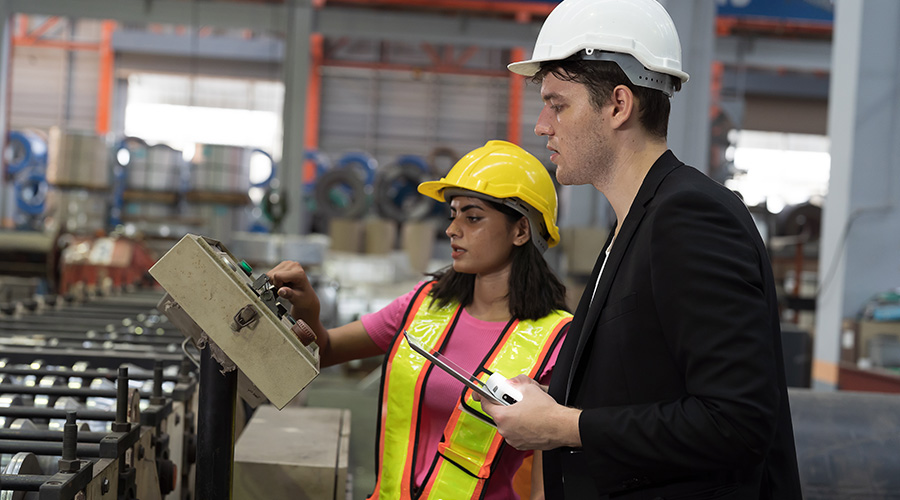The Second Time Around
Concrete steps can be taken to ensure that operational knowledge is part of the renovation plan
It’s no secret that executing a successful renovation can be trickier than achieving success with new construction. Why? With a renovation, there is no starting from scratch: New design and space-utilization goals have to be achieved despite the presence of old systems and structural components. For this reason, a successful renovation requires far more than a solid architectural drawing. It demands an in-depth understanding of the systems and components, and the quirks and peculiarities of buildings. A renovation that is planned and executed without this operational perspective is a recipe for all kinds of frustrations: change orders, long-term building management problems and unhappy end-users.
A Critical Consideration
Regardless of the types of facilities they manage or the scope of the projects they oversee, facility executives who have experience executing renovations agree that incorporating operational knowledge about the facility into a renovation plan is extremely important.
“As-builts are not particularly accurate,” says Jeff Moore, vice president of facilities,Wintergreen Resort. “Things change after the construction of any facility and the operational history of the building is sometimes the only way to find out where those changes have taken place, and where the original drawings do or do not reflect reality.”
In addition, says Tom Heller, vice president of national facility services, Kaiser Permanente, “You need information about the existing conditions around systems. Many times there are deficiencies in systems that need to be recognized before completing any kind of design.”
For instance, making sure the design team understands early on how a facility’s mechanical, plumbing and IT systems relate to each other can help eliminate the disruptions and setbacks that can occur when these systems are considered separately. Code compliance issues can be addressed far more affordably and easily if they surface early in the process. And the historical usage patterns and structural characteristics of the facility should inform decisions about how renovated space will be utilized.
“If we’re putting in a heavy filing system or a vault that requires a certain level of structural integrity, operational knowledge about the floors would influence our decision about where that item should go,” says George Lockhart, vice president, corporate properties group, Wells Fargo.
Operational understanding about how a facility is used by occupants can also be critical in specifying the best systems and materials.
“Say the design team has to decide whether to use carpet tile or broadloom in a particular location,” says Sanford Smith, corporate manager for real estate and facilities, Toyota. “Operational history can tell us about the area’s wear patterns, and that can have a major impact on decision-making. The choice may be to use carpet tile, which is more expensive, but maintaining it in a high-traffic area will be cheaper in the long run. That information may also drive color choice.”
Clearly, issues like these have ramifications not only for the performance of the facility over the long term, but also for the renovation’s budget.
“The biggest problem we get hit with is having to go back to the customer and say we need $50,000 more, and hearing them say, ‘Well, if we’d known that we would have made different arrangements,’ ” says Lockhart. “Having adequate operational information from the beginning can help us anticipate more accurately what the costs are likely to be so we don’t end up in that position.”
Harnessing the Knowledge
According to facility executives with experience managing renovations, there are concrete steps that can be taken to make sure that operational knowledge gets incorporated into every renovation plan.
“First, you have to have physical plant people who are knowledgeable enough to tell you where they think the problem areas are going to be,” says Richard Jones, associate director for construction and planning at the University of Miami.
Part of building that knowledge base, in Jones’ experience, is implementing policies to ensure that conditions and issues in the facility are carefully tracked and documented.
“We brought in consultants to identify all of the elements with limited life spans, ADA issues and any other deficiencies that were likely to present themselves,” he says. “Now we can use those findings as a baseline for knowledge about the operations of the facilities. We also try to keep current facilities operations reports on file for all of our buildings.”
Gathering and maintaining operations data is an important initial step; however, at least as important — and often more complicated — is making sure that the operations personnel who possess this information are brought into the planning process for the renovation.
“Ultimately, those are the people that have to operate the building,” says Ken Simmons, senior vice president, CarrAmerica Development. “They are the ones that have gained the experience from operating the building. It is absolutely critical that they be involved in the process of developing plans for a renovation.”
Holding regular meetings that include not only architects, engineers and design professionals, but also plant management staff members is a relatively simple way to include operations staff. While it is likely not realistic, or even useful, to have every member of the plant operations staff attend every renovation planning meeting, key members should attend all meetings. Others, such as engineers who manage and maintain specific building systems or floors, should be brought in as appropriate.
“It may not be the plant operations supervisor or director who ends up being most critical to have at the table,” says Heller. “Depending on what the renovation is and what systems are going to be affected, it may be more important to have the ongoing involvement of a staff member who has specific knowledge of an area.”
This involvement should continue throughout the project and beyond. Follow-up with the operations staff will provide the design team with valuable feedback on the effectiveness of the project. In the long run, the resulting lines of communication between the operations team and the design team can only benefit both departments and the organization.
“Over time, a relationship is formed,” says Lockhart. “Like any other relationship, it needs to be developed and credibility needs to be earned on both sides. Regular interaction and communication are the keys to that.”
Easier Said than Done
Despite the many advantages of a renovation plan that incorporates design priorities and operational knowledge, this integration is often more easily said than done.
“I think the need for collaboration between the design side and the operations side is widely recognized, but in practice it can be difficult to achieve,” says Heller.
“It adds complexity and work to the process,” adds Wintergreen Resort’s Moore.
One reason for this: The simple challenge of getting everyone in the same room at the same time.
“Sometimes you schedule time with the users to review the design with the architects and engineers there,” says Heller. “But despite best intentions, the operations people are either overlooked or are invited, and are not pursued by the design team. Operations folks are busy doing other things. The reality is that it’s hard to schedule operations staff.”
The problem is compounded at organizations where collaboration between design and operations has not been institutionalized as a cultural value. Indeed, it can be an uphill battle to facilitate the integration of operational information when there is resistance from either side.
“As architects, our educational process is really focused on the delivery of the ‘thing’ that is the building, and not on what it is going to be used for,” says Smith. “That can result in the operational side being overlooked or undervalued, and you do get some design folks who think they don’t need the operational perspective.”
Fortunately, it’s an attitude that many in the field say is changing.
“I would say most designers — particularly engineers — want the knowledge that building operations folks can provide,” says CarrAmerica’s Simmons. “Most of them understand the importance of that. My experience is that there is a tremendous amount of respect from the professional engineers toward the building operations engineers.”
Of course, operations personnel must also check any attitude at the door.
“There is a historical relationship in which the operations folks sit back and say, ‘I told you so,’ which is obviously counter-productive,” says Heller. “I believe that is changing, but it is still important for the operations side to be proactive. They’ve got an obligation to occupy that seat, and to have the right people there. They’ve got to do their part to overcome that old notion of sitting back and saying, ‘I told you so.’ ”
Role of the Facility Executive
Of course, few relationships develop effortlessly, and fostering the kind of collaboration that most benefits a renovation project means more than just scheduling meetings. For facility executives charged with overseeing both the design and operational aspects of a renovation, this involves the application of soft skills in addition to the management of logistics and processes.
For starters, facility executives need to project a clear message to all involved that incorporating operational knowledge into the process is a priority, and that nothing short of real collaboration is acceptable.
“A lot depends on the person who hires the architects,” says Moore. “That person has to want the operational perspective to be heard. If design professionals are not supportive of this process, then they are not the ones who should be hired.”
“The operations people need to know that from my perspective it is very important that they are involved,” adds Lockhart.
One way of sending this message can be structural — building a facilities operation that brings the design and operations functions under the same department. This is a key to building, Smith says, “a shared sense of destiny.”
Playing the Numbers Game
Another important decision may concern the budgeting process. Smith has found success using a common budget to foster collaboration between design and operations.
“If you don’t have shared budgetary responsibility then you are destined to have the design team always making decisions about the building and the operations team always having the ball thrown over the fence to them,” says Smith. “The common budget means that there is some creative tension involved in the process. But it also allows everyone to feel like they have a voice in the decision-making, and it forces the group to make the collective tradeoffs.”
At the same time, preserving some separation between operations and project budgeting may help to ensure that deferred maintenance does not skew renovation budgets.
“If the regular maintenance hasn’t been addressed through its own budget and on its own timeframe, you may have to absorb the cost of upgrading a whole floor of HVAC to do a small remodel,” says Heller. “You can end up having to scope your project differently.”
The facility executive also has an important task in helping to make sure that the design process is structured in a way that works for all concerned — not just architects, who have traditionally tended to drive the process. While most building professionals are technically capable of reading drawings, sitting around a table may not be the most useful way for operations personnel — who are used to viewing the building in a more hands-on way — to participate.
“Handing plant people a huge stack of specs and drawings is not helpful because it is overwhelming,” says Jones. “It is better to actually schedule times to walk them through the project and let them make observations and ask questions. No matter what it takes, you’ve got to get those guys to the table and make sure they understand what they are seeing and hearing.”
Regardless of how it is done, bringing a solid underpinning of operational knowledge and expertise into a renovation plan can be one of the most important tasks for a facility executive charged with overseeing renovations. And it can be one of the key determinants of end-users’ satisfaction with the overall job.
“The corporation isn’t issuing one report card for design and another for operations,” says Smith. “What we’re all — both the design folks and the operations folks — being evaluated on is how well the facility meets the needs of the corporation. Everybody’s got to remember that that is the only report card that matters.”
Abigail Gray is a writer who specializes in facility issues. She is the former editor of EducationFM magazine.
Related Topics:











